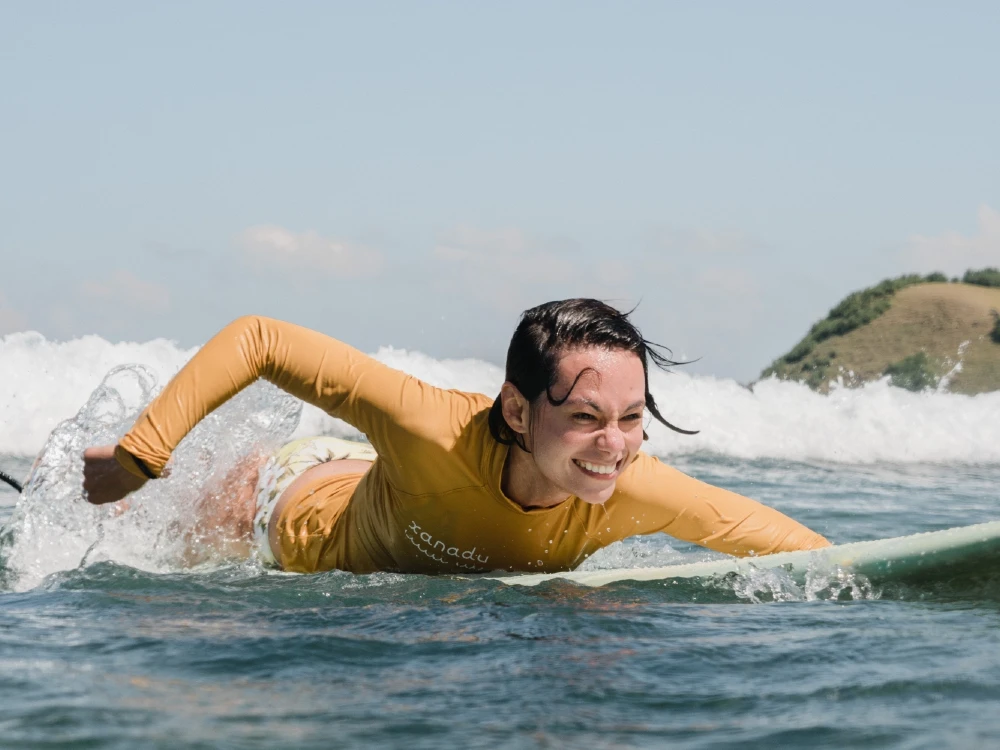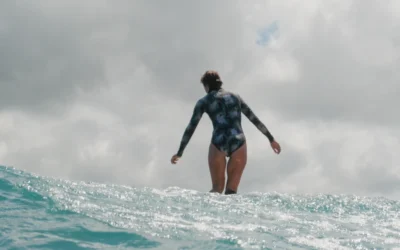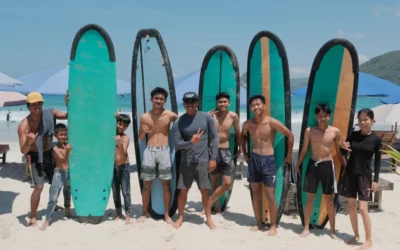It sounds kinda cliche, but surfing is a journey.
For some, it starts with wobbly whitewater rides and hair-plastered-to-your-face wipeouts. For others, it’s about sharpening turns, reading the ocean or chasing bigger waves with confidence.
At Xanadu, we know no two surfers are the same. So why would we teach everyone the same way?
That’s why we break surfing progression into four distinct levels. Not to box people in, mind you. But to open the door to personalised coaching that actually meets you where you are.
In this article, we’ll walk you through what each surf level looks like, why categorising matters and how to figure out your own level before your next trip.
Let’s do it.
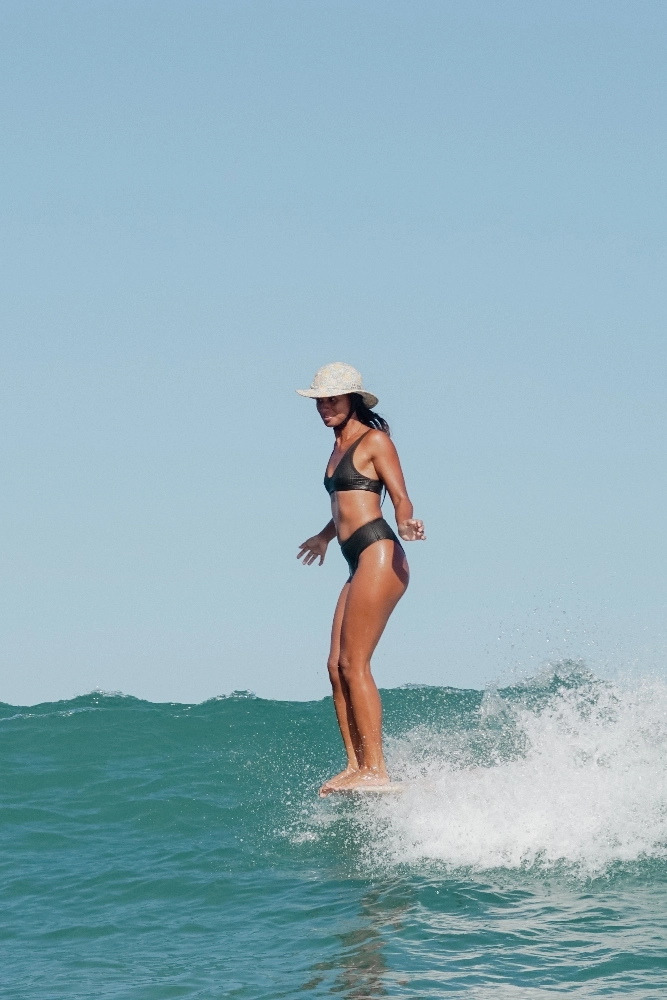
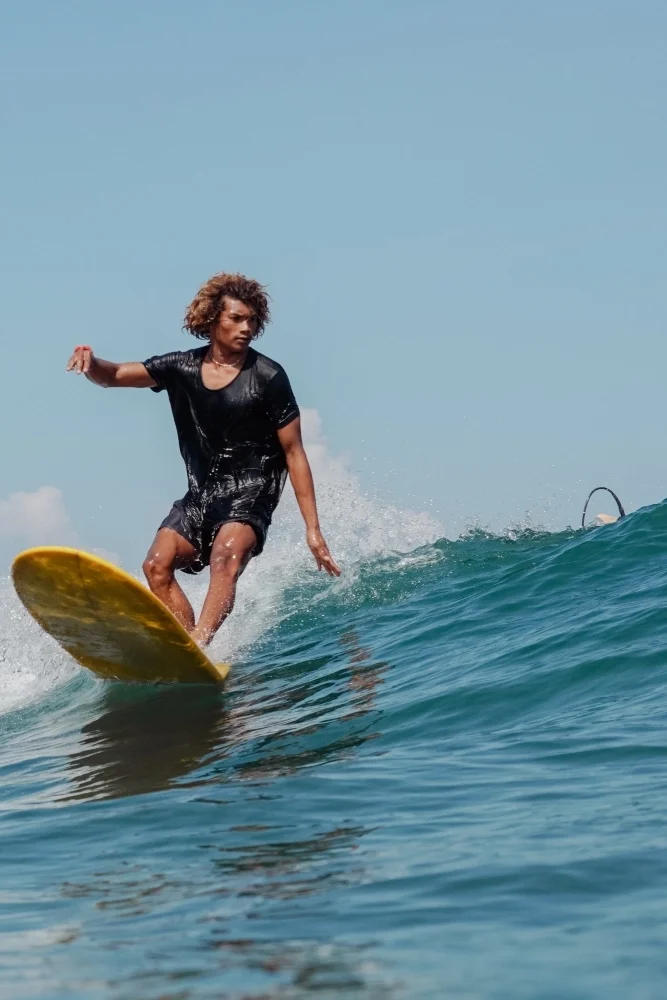
Why levels matter
Imagine walking into a yoga class with twenty people, all doing completely different poses. Some in child’s pose, some upside down in headstands. Without structure, how could the teacher guide anyone properly?
(Well, maybe Dani could… but she’s a rockstar!)
Surfing’s no different. By knowing your level, we can:
- Tailor surf lessons to your skills, confidence and style
- Keep progression safe by building strong foundations before moving on
- Create flow in the group so you’re surfing with people at a similar stage
- Measure growth so you can look back and see how far you’ve come
Keep in mind that levels aren’t labels. So don’t get too hung up on where you are.
For us, the following surfing levels are all about clarity. And clarity makes progress smoother, safer and more fun for everyone.
Why we don’t take a one-size-fits-all approach
At Xanadu, levels are just the start.
They help us group surfers so you’re learning alongside people with similar surfing ability, but from there it gets waaay more personal.
We’ve been doing this for a very long time. And one thing that’s clear is that every surfer has their own strengths, challenges and learning style. Some pick things up visually. Others need to repeat the same drill until it clicks. Some like breaking techniques down step by step. Others are more comfortable “feeling” it out then “thinking” it through. No judgments here!
We adapt to whatever works best for you. That means tailored guidance shows up everywhere:
- On the beach, where we’ll fine-tune your pop up, stance and paddling
- In the ocean, where we’ll gently call out tips as you catch waves
- During video analysis, where you’ll watch your own surfing and get crystal clear feedback on what to fix next
- On land, where we’ll also introduce you to the finer points of surf forecasting and surf conditions
That’s why progress here sticks. It’s not just about surfing more. It’s about surfing smarter and in line with your own learning style.
How we organise levels at Xanadu
To keep things smooth, we group surfers into four levels. Read the descriptions and pick the one that feels closest to where you are. Oh… and don’t overthink it!
You can move up or down as the week goes on – our instructors will help you choose the suitable level based on your skills and progression throughout the week. You also needn’t worry too much about being fit for surfing. We’ll accommodate your level of fitness!
Level 1
- For complete beginners or novice surfers who still struggle with the pop up or balance
- Focus on strong foundations, learning surf etiquette, board management and feeling safe in the ocean
- Great if you’re building confidence and want to enjoy your first real rides
Level 2
- You’ve nailed the pop up and are starting to link your first turns
- We’ll surf mellow forgiving waves where you can practice angled takeoffs and riding the wave’s face
- Perfect if you’re ready to move past the basics and start thinking like a surfer (i.e. surf etiquette, anticipating conditions, understanding surf forecasts and planning solo surf trips once you feel ready for those)
Level 3
- This intermediate level is ideal for anyone catching small green waves with confidence
- You’re working on improving your efficiency and flow
- You’re comfortable in the ocean and can handle slightly bigger sets
- You’re thinking of starting to cross-step or getting to the nose doing your first hang five if you’re riding a longboard
- This level is also suitable for intermediate surfers transitioning to be a future shortboarder
- This is where you commit to waves, trust your timing and develop rhythm in your surfing
Level 4 – MID-LENGTH & SHORTBOARDS
- For mid-length and shortboard riders who can paddle into waves on their own and hold position in the lineup
- You are able to catch your own waves (without a push)
- You’re chasing more challenging waves and working on more advanced maneuvers like cutbacks, snaps and floaters
- Best suited if you want to push limits, refine your style and stay composed in tougher conditions (bigger/steeper waves, shallower reefs)
Xanadu’s surfing levels 1–4
Now that you’ve got a snapshot of how we place surfers at the start of the week, let’s dive a little deeper. Each level has its own focus, milestones and challenges.
Think of this as the roadmap for your surfing journey… from your very first whitewater waves to confidently selecting good waves and performing advanced maneuvers.
Level one: The beginner
This is the fresh foam stage. Maybe you’ve never touched a surfboard before OR maybe you’ve had a few surf lessons but wouldn’t call yourself confident.
At this stage, we focus on:
- Getting comfortable in the ocean
- Learning surf etiquette and the unwritten rules of the lineup
- Getting to know your gear
- Practicing the pop up on land then in the white water waves
- Catching broken waves and feeling that first glide
- Board management (turtle rolls, spinning your board around to catch waves, more efficient paddling)
- Learning how to maintain your balance and start turning once you’re up
The main goal? Nailing the pop-up and confidence – this is the foundation of your surf journey. The ocean can feel intimidating, but once you’re riding whitewater waves and laughing through wipeouts, it starts to feel a bit less freaky and kinda fun.
Level two: The beginner-intermediate
You’re nailing your pop-up, catching whitewater waves on your own and you’re itching to progress. Small green waves are calling your name, though sometimes they slip away.
Here, coaching zeroes in on:
- Paddling technique and positioning for unbroken waves
- Timing your take off and trying angled entries
- Riding the wave’s face instead of just the foam
- Learning to trim, create speed and hold your line
- Getting used to surfing in a crowded lineup
This is where you shift to feeling more comfortable with your board in the open ocean. Mistakes are normal. Wipeouts are, well, pretty constant still. But every session you’ll feel your surfing skills stack up.
Level three: The intermediate longboarder or midlength rider
Now you’re catching unbroken waves regularly without being pushed into the wave. You can angle your take off, turn the longboard or a bigger board, and you’ve maybe started thinking about taking your first steps to the nose or reaching for your first hang five OR you are an intermediate surfer in the process of transitioning to a shortboard. BUT… you still know you’re only scratching the surface.
Our focus at this level includes:
- Refining turns, efficiency and flow
- Cross-steps on a longboard (if you ride a longboard)
- Reading waves to know when to speed up and when to hold back
- Paddling into different surf conditions and surf spots with confidence
The big difference now? Intentional surfing. You’re not just reacting anymore. You’re making decisions, selecting waves and starting to shape your own style.
Level four: The upper intermediate and advanced shortboard or mid-length rider
You’re comfortable in a wide range of surf conditions. You know how to read waves, paddle into bigger sets and mix with other surfers in the lineup and control your board. Your maneuvers are sharper and you’re experimenting with refining your technique.
At this stage, coaching gets super detailed:
- Critical maneuvers like snaps, floaters and advanced cutbacks
- Wave selection strategies for head high or more challenging waves
- Upper body movement workshop
- Break down every detail of your technique
Here the aim isn’t just progress… it’s evolution. Surfing becomes a craft that you keep honing, whether you’re chasing tubes or working on cleaner surfing from start to finish.
How do I know my level?
Surfers often underestimate themselves. Others oversell. The truth is usually somewhere in between. Ask yourself:
- Can I pop up consistently? (If not, you’re level one)
- Can I turn my board both left and right? (That’s level two)
- Can I ride the face of the wave and perform successful turns both left and right on a midlength or a longboard? (That’s level three)
- Do I ride shortboard or midlength and feel comfortable in larger conditions with potential steep waves and shallower reef? (That’s level four)
Still unsure? Don’t worry. Our surf coaches will help you place yourself. And it’s always better to start one step lower and move up than the other way around.
FAQ: surf levels explained
Q. What’s the difference between white water waves and green waves?
Whitewater waves are broken waves close to shore. They’re perfect for beginners building confidence. Green waves are unbroken waves further out where surfers start riding along the wave’s face.
Q. Do I need a few surf lessons before joining a surf camp or retreat?
Nope. Lots of our guests start their surfing journey here. A surf camp or surf retreat is actually the best place for a beginner surfer because you get daily coaching, video feedback and a crew cheering you on.
Q. How do I know if I’m ready for more challenging waves?
If you can paddle into unbroken waves, create speed and perform basic maneuvers without losing balance, you might be ready to step it up. Our surf coaches will guide you when the time’s right.
Q. What if I choose the wrong surf level?
No stress. You can move up or down during the week. Progress isn’t linear. Some days you’ll push, other days you’ll focus on foundations. That’s normal.
Q. Why does Xanadu use surf levels?
Surf levels help us group surfers with similar skills. We also do this to choose the best surf spots tailored to the group’s abilities and skills. But once you’re in, coaching gets tailored to your specific goals, learning style and challenges.
Conclusion
Keep in mind that your surf level isn’t a box to get stuck in.
It’s just a starting point, a way to map where you are so you can move forward with confidence. The ocean’s always changing and so is your surfing. Some days you’ll catch unbroken waves with ease. Other days you’ll tumble in the white water and laugh it off. That’s all part of the ride.
At Xanadu, we’ll meet you at your level and give you the tools to take the next step in your surfing journey.
Whether you’re a complete beginner or a highly skilled surfer chasing more challenging waves, there’s always another layer to explore. Join us for a retreat that’s personal, fun and built around your growth.
The waves (and your mates at Xanadu) are waiting!
Take it from us. We’ve helped a lot of surfers level up over the years. Thousands, in fact.

